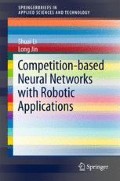Abstract
In this chapter, different from the model presented in Chap. 1, we present a continuous-time dynamic model, which is described by an ordinary differential equation and is able to produce the winner-take-all competition by taking advantage of selective positive-negative feedback. The global convergence is proven analytically and the convergence rate is also discussed. Simulations are conducted in the static competition and the dynamic competition scenarios. Both theoretical and numerical results validate the effectiveness of the dynamic equation in describing the nonlinear phenomena of winner-take-all competition.
Access this chapter
Tax calculation will be finalised at checkout
Purchases are for personal use only
References
Dun EA, Ferguson JD, Beveridge CA (2006) Apical dominance and shoot branching. divergent opinions or divergent mechanisms? Plant Physiol 142(3):812–819
Lee DK, Itti L, Koch C, Braun J (1999) Attention activates winner-take-all competition among visual filters. Nat Neurosci 2(4):375–381
Emilio H, Lopez C, Pigolotti S, Andersen K (2008) Species competition: coexistence, exclusion and clustering. Philos Trans R Soc A Math Phys Eng Sci 367(3):3183–3195
Jin L, Li S (2017) Distributed task allocation of multiple robots: A control perspective. IEEE Trans Syst Man Cybern: Syst pp(99):1–9
Maass W (2000) On the computational power of winner-take-all. Neural Comput 12(11):2519–2535
Liu S, Wang J (2006) A simplified dual neural network for quadratic programming with its kwta application. IEEE Trans Neural Netw 17(6):1500–1510
Hu X, Wang J (2006) An improved dual neural network for solving a class of quadratic programming problems and its \(k\)-winners-take-all application. IEEE Trans Neural Netw 19(12):2022–2031
Li S, Liu B, Li Y (2013) Selective positive-negative feedback produces the winner-take-all competition in recurrent neural networks. IEEE Trans Neural Netw Learn Syst 24(2):301–309
Jin L, Zhang Y, Li S, Zhang Y (2016) Modified ZNN for time-varying quadratic programming with inherent tolerance to noises and its application to kinematic redundancy resolution of robot manipulators. IEEE Trans Ind Electron 63(11):6978–6988
Jin L, Zhang Y (2015) Discrete-time Zhang neural network for online time-varying nonlinear optimization with application to manipulator motion generation. IEEE Trans Neural Netw Learn Syst 27(6):1525–1531
Li S, Zhang Y, Jin L (2016) Kinematic control of redundant manipulators using neural networks. IEEE Trans Neural Netw Learn Syst. doi:10.1109/TNNLS.2016.2574363 (In Press)
Li S, He J, Rafique U, Li Y (2017) Distributed recurrent neural networks for cooperative control of manipulators: a game-theoretic perspective. IEEE Trans Neural Netw Learn Syst 28(2):415–426
Jin L, Zhang Y, Li S (2016) Integration-enhanced Zhang neural network for real-time varying matrix inversion in the presence of various kinds of noises. IEEE Trans Neural Netw Learn Syst 27(12):2615–2627
Jin L, Zhang Y, Li S, Zhang Y (2017) Noise-tolerant ZNN models for solving time-varying zero-finding problems: a control-theoretic approach. IEEE Trans Autom Control 62(2):577–589
Jin L, Zhang Y (2016) Continuous and discrete Zhang dynamics for real-time varying nonlinear optimization. Numer Algorithms 73(1):115–140
Li S, Li Y (2014) Nonlinearly activated neural network for solving time-varying complex sylvester equation. IEEE Trans Cybern 44(8):1397–1407
Jin L, Li S, La H, Luo X (2017) Manipulability optimization of redundant manipulators using dynamic neural networks. IEEE Trans Ind Electron pp(99):1–10 In press with doi:10.1109/TIE.2017.2674624
Zhang Y, Li S (2017) Predictive suboptimal consensus of multiagent systems with nonlinear dynamics. IEEE Trans Syst Man Cybern: Syst pp(99):1–11, In press with doi:10.1109/TSMC.2017.2668440
Jin L, Zhang Y, Qiu B (2016) Neural network-based discrete-time Z-type model of high accuracy in noisy environments for solving dynamic system of linear equations. Neural Comput Appl. In press with doi:10.1007/s00521-016-2640-x
Li S, Zhou M, Luo X, You Z (2017) Distributed winner-take-all in dynamic networks. IEEE Trans Autom Control 62(2):577–589
Jin L, Zhang Y (2015) G2-type SRMPC scheme for synchronous manipulation of two redundant robot arms. IEEE Trans Cybern 45(2):153–164
Li S, Cui H, Li Y (2013) Decentralized control of collaborative redundant manipulators with partial command coverage via locally connected recurrent neural networks. Neural Comput Appl 23(1):1051–1060
Li S, You Z, Guo H, Luo X, Zhao Z (2016) Inverse-free extreme learning machine with optimal information updating. IEEE Trans Cybern 46(5):1229–1241
Khan M, Li S, Wang Q, Shao Z (2016) CPS oriented control design for networked surveillance robots with multiple physical constraints. IEEE Trans Computer-Aided Des Integr Circuits Syst 35(5):778–791
Khan M, Li S, Wang Q, Shao Z (2016) Formation control and tracking for co-operative robots with non-holonomic constraints. J Intell Robot Sys 82(1):163–174
Ramirez-Angulo J, Ducoudray-Acevedo G, Carvajal R, Lopez-Martin A (2005) Low-voltage high-performance voltage-mode and current-mode wta circuits based on flipped voltage followers. IEEE Trans Circuits Syst II: Express Br 52(7):420–423
Benkert C, Anderson DZ (1991) Controlled competitive dynamics in a photorefractive ring oscillator: winner-takes-all and the voting-paradox dynamics. Phys Rev A 44(1):4633–4638
Isidori A (1995) Nonlinear control systems. Springer, New York
LaSalle JP, Lefschetz S (1973) Stability by Liapunov’s direct method with applications. Academic Press, New York
Khalil H (2002) Nonlinear systems. Prentice Hall, New York
Author information
Authors and Affiliations
Corresponding author
Rights and permissions
Copyright information
© 2018 The Author(s)
About this chapter
Cite this chapter
Li, S., Jin, L. (2018). Competition Aided with Continuous-Time Nonlinear Model. In: Competition-Based Neural Networks with Robotic Applications. SpringerBriefs in Applied Sciences and Technology. Springer, Singapore. https://doi.org/10.1007/978-981-10-4947-7_2
Download citation
DOI: https://doi.org/10.1007/978-981-10-4947-7_2
Published:
Publisher Name: Springer, Singapore
Print ISBN: 978-981-10-4946-0
Online ISBN: 978-981-10-4947-7
eBook Packages: EngineeringEngineering (R0)

